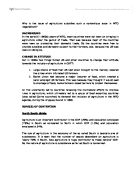The controversy and the future of Common Agricultural Policy of European Union
The controversy and the future of Common
Agricultural Policy of European Union
Problems/benefits
Effect of enlargement
Agriculture is a problematic area in every developed country. Free market economy that allows direct competition of agricultural products can often cause a surplus or shortage of certain products, and quality changes. In order to ensure reliable supply of food member states of the European Union decided to cooperate and transferred the authority over agriculture policy to European level. Common Agricultural Policy was set in 1961 and its aims were to improve production and solve existing problems in agriculture all over EU member states. The previous successes of cooperation with coal and steel, and the fact that most states had difficulties to produce certain goods logically led to deeper cooperation in agriculture, and to CAP. Today, “CAP is regarded as the most developed of the European Union’s policies and covers almost 90% of all agricultural products” (reader). But, also it is regarded as the most controversial and has been responsible for some negative consequences on the industry, and it had to go under many reforms. This essay will explain why CAP has been both celebrated and criticized. Also, it will include the challenges that will be put in front of it by the future enlargement of European Union.







